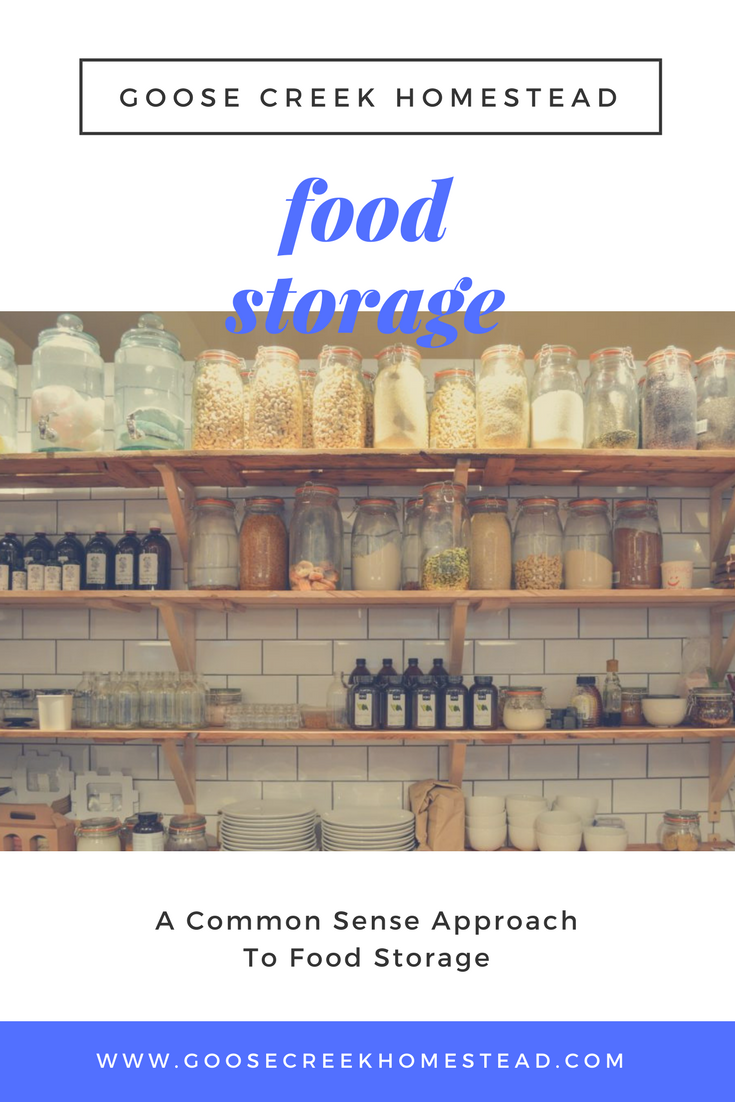Every household needs a food storage plan. In this commonsense guide to food storage for beginners, we’ll take the mystery out of where to start and which foods to store.
When I first became interested in preparedness, self-sufficiency, and homesteading, I read everything I could find on the subject of food storage. There is so much information out there on this subject. I became overwhelmed before I even got started.
I am not a big fan of the food storage lists you see all over the internet because every family’s needs and situation are so different. Over time, I have developed a common-sense approach to food storage that makes sense for our family.
Where to Start: How to Make a Food Storage Plan That Works for Your Family
To make a food storage plan that works for your family, start by asking yourself a few questions:
- What are the most likely natural disasters in your area?
- Is your job very secure, or are you likely to lose it without notice?
- Do you have a second income stream in case you or your spouse are sick or injured and can’t work for a while?
- Are you fairly food self-sufficient, or do you get the majority of your groceries from the grocery store?
- Don’t forget to consider the state of the country and the world as well! How concerned are you about the economy and the possibility of economic collapse, war, terrorism, or pandemics affecting your daily life?
Considering all of these factors should help you determine how much food storage you need. Think about worst-case scenarios here. How long would you likely have to live off of your food storage in these events before you could resupply? And how many people will be counting on you for food?
The Different Types of Emergency Food Storage
There are also several different levels of emergency food storage to consider.
Short-term food storage is made up of shelf-stable foods like canned goods and boxed foods that are easy to prepare without a lot of water or electricity. They are ideal after a quick meal after a natural disaster or short-term power outage.
Long-term food storage is made up of high-calorie, nutrient-dense, staple foods that are packed for long-term storage in #10 cans, 5-gallon buckets, and mylar. It will likely be made up mostly of dry goods like grains, legumes, pasta, home-dehydrated foods, and freeze-dried foods. This is the type of food to store when you’re planning for long-term or indefinite scenarios. When stored properly in a cool, dark place, it should last for years and be there when you need it unexpectedly.
Your Working Pantry: If you are doing a lot of cooking from scratch, you will also have food storage that falls somewhere in the middle between short and long-term storage in your everyday working pantry.
It could include things like food from the garden, home-canned foods, dehydrated foods, and fermented foods. It also includes store-bought staples you use regularly, as well as the food in your fridge and freezer.
A well-stocked working pantry that you are rotating through regularly is essential to any prepper’s food storage plan. Your working pantry is what will get you through the tough times, such as job loss or illness, and add variety to your short and long-term emergency storage foods.
Food Storage for Beginners: A Step-By-Step Plan
Here’s how we created a food storage plan that works for our family. You can this plan to make it work for you and your family.
1. Start With Short-Term Food Storage
We felt that we needed to be prepared for natural disasters, such as snowstorms and tornados. A typical winter storm in the Blue Ridge Mountains could take out the power for up to two weeks or more.
Just to be safe, we decided to stock a one-month supply of canned and boxed foods that could be easily prepared without using a lot of electricity or water.
This is not the type of food we use every day. It is mostly convenience, heat-and-eat type of food like canned soups and boxed macaroni and cheese. We watch the expiration dates and use it or donate it before it expires.
2. Build a Working Pantry
In the event of serious illness or injury, job loss, or some other serious financial crisis, we would rely on our everyday working pantry. Ours consists of home-canned and dehydrated foods, as well as foods we use regularly when cooking meals from scratch on a daily basis.
We do almost all of our cooking from scratch and try to use homegrown foods as much as possible. We keep a variety of herbs, spices, baking supplies, and cooking oils in our everyday use pantry and rotate through them regularly.
We also consider the foods in our fridge and freezer part of our working pantry. In the event of a long-term power outage, we would have to use the items in the fridge first. We would also have to find another way to preserve frozen items, such as canning, fermenting, or dehydrating, so we stock food preservation supplies as well.
In the end, we decided to keep a six-month supply of food in our working pantry at all times, in case one of us was seriously injured or ill, we had a temporary loss of income, or in case of a disruption in the food supply chain.
3. Create a Long-Term Food Storage Plan
Long-term storage foods are what will help you get through an economic collapse, pandemic, war, or other long-term or indefinite crisis. This type of food is the backbone of a prepper’s food storage plan.
It should include things like whole grains that you can grind into flour, rice, dry beans, pasta, sugar, and honey. Don’t forget to add essential fats like oils for cooking and rotate them frequently.
Remember, you don’t have to buy all of this at once. You can start with a one-month supply, then three months, and slowly build it up from there as it makes sense to you.
We decided to keep a one-year supply of staple dry goods and other items we can’t produce ourselves. Of course, this number will vary from family to family, depending on your budget, space, and what you’re preparing for.
4. Think About Resupply and Self-Sufficiency
I also considered things like chickens and quail for eggs and meat, dairy animals like goats or milk cows, growing our own microgreens, and seeds for our gardens, as well as the potential to hunt and fish, when I created our food storage plan.
We already try to produce as much of our own food as possible, and we try to have a variety of food sources producing on our homestead year-round. We also preserve as much of that food as we can.
Whether you’re preparing for a short-term loss of income or an indefinite economic collapse, growing as much of your own food as possible just makes sense. You can grow lots of food indoors with the right setup, even if you live in an apartment, so don’t let that stop you!
The Bottom Line
Having a food storage plan is essential for every household, but you don’t have to buy it all at once. Start with what you would need to get by in a short-term emergency and work up from there, as it makes sense to you.
At the end of the day, becoming more self-sufficient will help you get through anything from a short-term emergency to an indefinite crisis. Becoming as self-sufficient as you can, wherever you are, should be the ultimate goal of any preparedness-minded individual and something you work toward daily.






